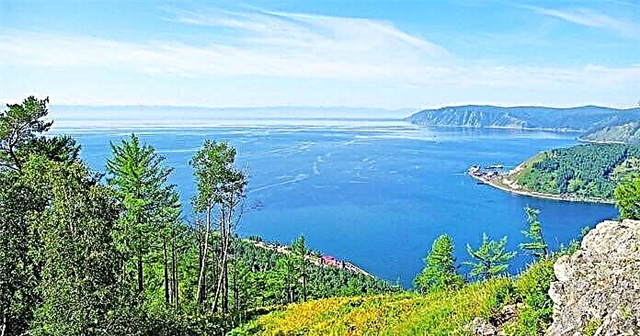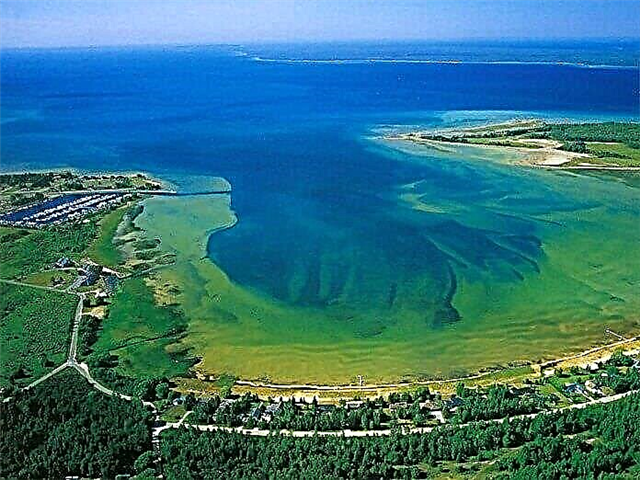Lakes with their crystal clear waters, rich ecosystems and peaceful landscapes are some of the most magnificent natural wonders the world has to offer. In addition to their positive moods, the lakes can be staggeringly large.
Here is a list of the 10 largest lakes in the world that you can add to your checklist of places to visit in the future.
10. Great Slave Lake, Canada - 28,930 km²
 Canada’s second largest lake is also the deepest lake in all of North America. To reach its bottom you will have to swim down 614 meters.
Canada’s second largest lake is also the deepest lake in all of North America. To reach its bottom you will have to swim down 614 meters.
The Great Slave Lake used to be part of the vast McConnell Glacier Lake. And now it is known for its houseboats, which are completely self-sufficient. A documentary ("Ice Lake"), which was shown on the Animal Planet channel, was even shot about them.
Despite its name, this lake was not the last refuge for hundreds of slaves, and was not a place on which boats full of slaves sailed back and forth daily.
The name Great Slave Lake was given in honor of one of the names (slaves) of the Dene Indian people. And the translators felt that it comes from the English word slave ("slave").
9. Nyasa, Africa - 30,044 km²
 This is the southernmost lake of the Rift Valley in Tanzania (East Africa). Contains 7% of the world's fresh water reserves.
This is the southernmost lake of the Rift Valley in Tanzania (East Africa). Contains 7% of the world's fresh water reserves.
Nyasa Lake (or Malawi, but the name of the republic where it is located) is home to more fish species than any other lake on the planet. Only cichlids in it have at least 700 species.
And if you get tired of admiring local fish and snails, you can always relax on one of the beautiful beaches and get a good tan under the bright African sun.
8. Big Bear Lake, Canada - 31,080 km²
 It is the largest lake in Canada. And it is located interestingly - right on the Arctic Circle, where the taiga and tundra regions border.
It is the largest lake in Canada. And it is located interestingly - right on the Arctic Circle, where the taiga and tundra regions border.
It was here that the first uranium deposits were discovered. 9 months a year the lake is covered with ice, so the shipping period is very short.
But fishing and hunting are great here. It’s not easy to get here, but if you do, you won’t regret it, because the places near the Big Bear Lake are beautiful. And the settlements surrounding the lake are home to the indian Native American people of Dene and the "bear people" of tipi. So if you have long dreamed of seeing real Indians (albeit quite modern, rather than waving tomahawks), then you know where to go.
7. Baikal, Russia - 31,500 km²
 Before you is the deepest lake in the world, and this is far from the only interesting fact about Lake Baikal. Its greatest depth reaches 1642 meters. Contains the largest reserves of fresh water. It is also the cleanest lake on the planet.
Before you is the deepest lake in the world, and this is far from the only interesting fact about Lake Baikal. Its greatest depth reaches 1642 meters. Contains the largest reserves of fresh water. It is also the cleanest lake on the planet.
Lake Baikal is located at an altitude of more than 455 meters above sea level and serves as a home for 1000 species of plants and 2500 species of animals. One of the unique animals that have chosen Baikal is a freshwater seal or Baikal seal. Until now, scientists do not know exactly how this animal appeared in the waters of the lake - either sailed from the Arctic Ocean through the river system, or from the Lena River, into which there could be a drain from Baikal.
But having settled down in a new place, the pinniped traveler still feels excellent, having risen to the top of the food chain in the ecosystem of Lake Baikal. The only danger to the Baikal seal is humans.
6. Tanganyika, Africa - 32,893 km²
 This great African lake is the second oldest freshwater lake in the world and, in addition, the longest freshwater lake in the world.
This great African lake is the second oldest freshwater lake in the world and, in addition, the longest freshwater lake in the world.
More than 85 percent of the lake is in Tanzania and DR Congo, and the remainder is in Burundi and Zambia.
Tanganyika is home to many crocodiles and hippos, as well as ringed aquatic cobra - one of the most beautiful and calm species of cobra in the world. Beginning terrariums even recommend these cobras as their first pet because of their peaceful nature.
5. Michigan, USA - 58,000 km²
 Included in the Great Lakes system along with Upper and Huron. These three lakes are connected into a single system by straits, but they are considered to be separate lakes.
Included in the Great Lakes system along with Upper and Huron. These three lakes are connected into a single system by straits, but they are considered to be separate lakes.
The vast coastline of Lake Michigan is sometimes called the "third shore" of the United States due to its long beautiful beaches.
4. Huron, USA - 59,600 km²
 It boasts the longest coastline of all the Great Lakes and was the first of the lakes that Europeans explored in the 1600s.
It boasts the longest coastline of all the Great Lakes and was the first of the lakes that Europeans explored in the 1600s.
French explorers Samuel de Champlain and Etienne Brule discovered the Huron Bay in 1615, at first counting it as a separate lake, since it seemed to be Manitulin Island separated from the rest of Lake Huron. However, given that this island is considered the largest in the world, researchers can be understood.
3. Lake Victoria, Africa - 69,485 km²
 The third largest lake in the world, located in East Africa in the territory of 3 states. Third in terms of fresh water reserves after Upper and Baikal. Named after Queen Victoria by the British traveler and discoverer John Speke.
The third largest lake in the world, located in East Africa in the territory of 3 states. Third in terms of fresh water reserves after Upper and Baikal. Named after Queen Victoria by the British traveler and discoverer John Speke.
This lake is also the main reservoir and source of the magnificent Nile River.
Victoria has 85 different islands, each of which is located within Uganda, with the exception of one located in Kenya. All of these islands are famous for their endemic fauna that inhabit a richly hydrated ecosystem. Simply put, the animals that live there are not found anywhere else. No wonder this attracts crowds of tourists to the islands.
2. Lake Superior, Canada and the USA - 82,414 km²
 Located on the border of Canada and the United States, this lake is the largest freshwater lake in the world. It contains more water than all the other Great Lakes combined.
Located on the border of Canada and the United States, this lake is the largest freshwater lake in the world. It contains more water than all the other Great Lakes combined.
The original name was translated as "Big Water", then as "the highest lake", but was later renamed with the proviso that it is the largest on the continent.
1. The Caspian Sea - 371,000 km²
 Despite the geographical name “sea”, the Caspian is the largest lake on Earth in size. It is called the sea because of the tectonic features of the oceanic type, but in essence it is a large drainage lake, the water level of which is subject to constant fluctuations. Although several rivers connect to the Caspian Sea, it still remains completely separate from the ocean.
Despite the geographical name “sea”, the Caspian is the largest lake on Earth in size. It is called the sea because of the tectonic features of the oceanic type, but in essence it is a large drainage lake, the water level of which is subject to constant fluctuations. Although several rivers connect to the Caspian Sea, it still remains completely separate from the ocean.

The Caspian is located on the border of Europe and Asia, has a different level of salinity, from 0.05% at the mouth of the Volga, to 13% in the south.
The outsider, having dropped out of the dozens of the largest lakes, is the Aral Sea, which is a large salt lake, without flow into the ocean. The shallowing process has led to the fact that its water surface area has decreased to 8303 km².












